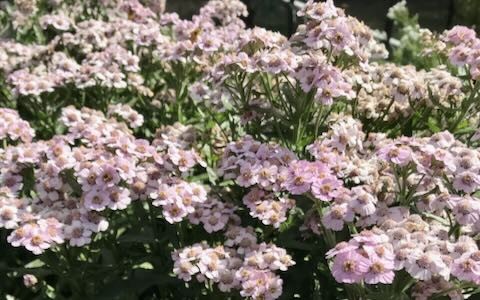
Diplarrena moraea
Tasmanian native flag iris, useful in combination with grasses and perennials. Lovely and abundant white flowers in spring, evergreen leaves and drought hardy.


New variety from our trial beds, a lovely pink form which is an offspring from Achillea 'Love Parade', demonstates all the rubustness of other achillea varieties. Once established best not overly fertilized to maintain upright habit, as with other varieties.
New variety from our trial beds, a lovely pink form which is an offspring from Achillea 'Love Parade', demonstates all the rubustness of other achillea varieties. Once established best not overly fertilized to maintain upright habit, as with other varieties.
Data sheet
Tasmanian native flag iris, useful in combination with grasses and perennials. Lovely and abundant white flowers in spring, evergreen leaves and drought hardy.
Remarkable silver foliage plant, with vigourous trailing groundcovering habit; suits hanging basket or drystone wall. Extremely tough and adaptable.
A mix of our lupin colour range, from white to reds, pinks, blues and purples.
Low mounding variety that will trail over a wall or amongst rocks, likes drained drier soil types. Tasmanian native, very pretty plant and surprisingly tough, will withstand summer dry.
The beautiful 'snakes head' Fritillaria. Easy to grow but requires drainage, moderate fertility with organic matter content in the soil and a cool position. Best in part shade in the rockgarden, or in a large pot or raised bed. Colour can vary from pink to purple, rarely but occasionally white.
Rarely offered miniature for the rock garden with mounding habit. Porcelain blue bells on wiry upright stems, astounding flowers for such a dwarf plant. Will also grow well in the cottage garden or a pot if given occasional lime.
Pink form of Astrantia major: a good companion for hostas and dicentras in woodland.
Beautiful variation of the species from Crete, originally from Marcus Harvey. Winter flowering, and a great compact structure plant in rock gardens amongst dwarf bulbs and cyclamen. Low mounding shape with grassy foliage , cold and drought hardy, long lived and only 25cm high. Overall great plant.
Clumping plant liking moister soils in woodland and part shade or morning sun. Attractive whorls or pink flowers amongst good foliage. Likes growing with Siberean iris, ligularia, and astilbe.
Rare white form of the usual blue, useful for ground cover in part shade or sun. Vigorous and spreading like the blue form.
Late summer filler for perennial border, flowering from summer into winter. An easy plant that will in fill nicely between penstemons, euphorbias and dahlias. Dead head to prolong flowering, purple flowers on tall airy stems.
A terrific low growing variety for foreground plantings, only just over knee high and easier to manage than some of the larger kniphofia. Colourful burnt orange flowers in summer look good with rudbeckia, grasses and sedums.
White flowered low spreading ground cover for full sun preferring loose drained soil types. Useful for foreground and border plantings.
A delightful variety for moist fertile soil in shade or part sun, pink flowers and good clumping habit, looks good in both woodland and herbaceous border plantings.
White flowered form of E.comosa, strappy foliage and summer flowering, showy plant, winter deciduous, large bulbs.
Semi double almost black from our own breeding, vigorous and strong grower compared to others. Gravelly soil and full sun with some lime.

New variety from our trial beds, a lovely pink form which is an offspring from Achillea 'Love Parade', demonstates all the rubustness of other achillea varieties. Once established best not overly fertilized to maintain upright habit, as with other varieties.